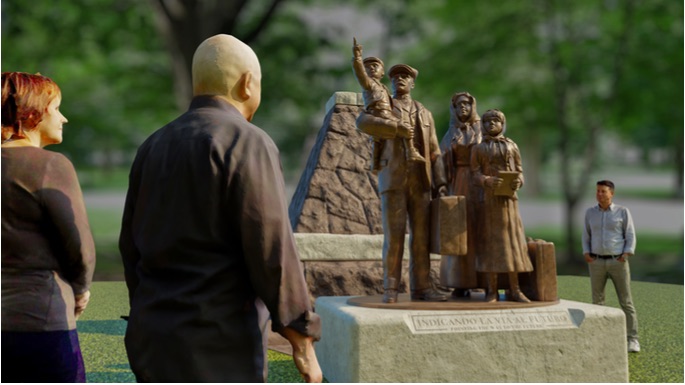
Public art | Arts & Culture | Wooster Square | History
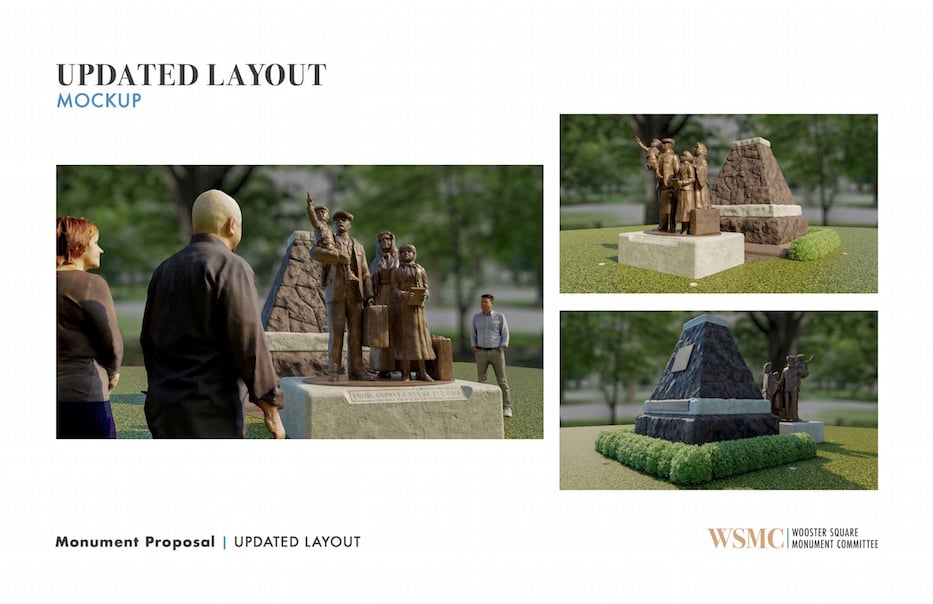
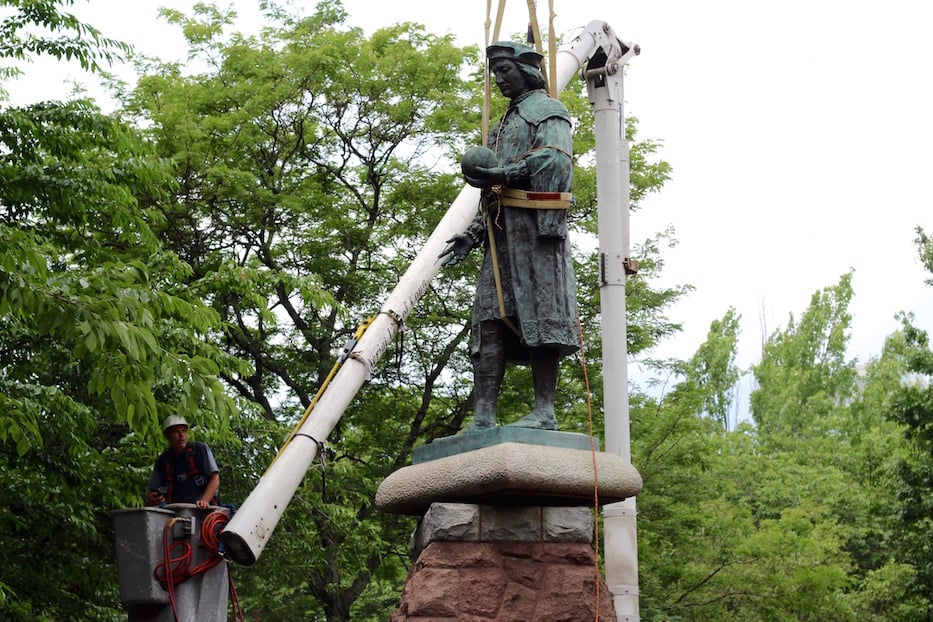
Top: Renderings in the current proposal. Bottom: Columbus comes off the pedestal (or is it a plinth?) in June 2020.
The statue of Christopher Columbus is gone. The pedestal will remain—in front of another statue.
That news came out of the Historic District Commission Wednesday night, as members of the Wooster Square Monument Committee (WSMC) presented their latest proposal for Marc-Anthony Massaro's Indicando la via al futuro (Pointing the Way to the Future) in Wooster Square Park. In the most recent rendering, Massaro's bronze sculpture sits atop a two-foot granite base, behind the historic stone plinth built by local stonemasons 132 years ago.
In other words, the new sculpture will still sit in Columbus’ old shadow, just without Columbus.
In a three-two voice vote, commissioners approved the proposal. Commissioners Susan Godshall, Tom Kimberly and Dylan Christopher voted in favor of the application. Commissioners Karen Jenkins and Doug Royalty voted against it, largely on the basis of the pedestal/plinth remaining in the park. Read the committee’s full proposal, including renderings, here.
It is the fourth time that the committee, a group of 27 members tapped by Mayor Justin Elicker after a statue of Christopher Columbus came down in June 2020, has appeared before the Historic District Commission. The group received a conditional approval from the commission in February, but hit a snag when it was asked for revisions early last month. The freshly-approved design now goes on to the New Haven Parks Commission, Cultural Affairs Commission, and the full New Haven Board of Alders.
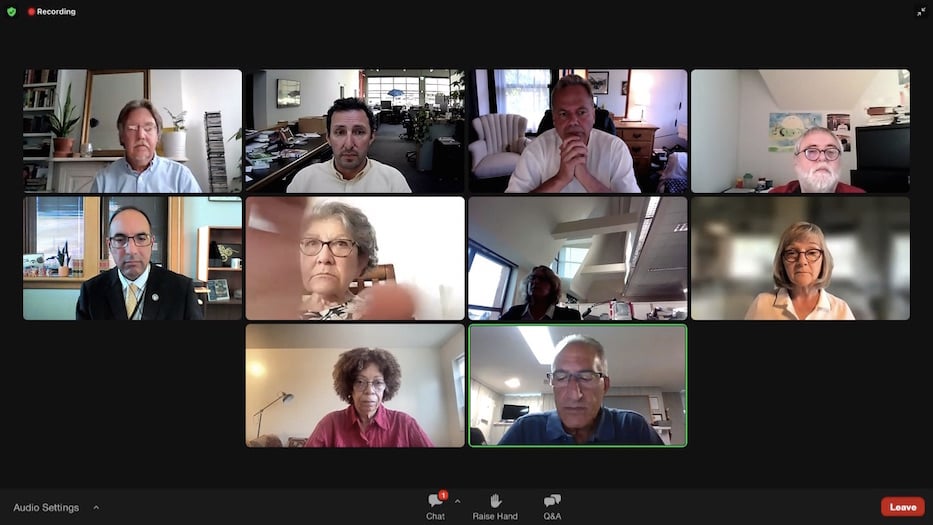
“It has been a challenge, but we are a persistent group and we have been very responsive,” said William Iovanne, Jr., who has served as co-chair of the Monument Committee for over two years, in a phone call directly following the vote. “I think that the key to this was to take the criticisms from both the committee and the commissioners and integrate them into our proposal.”
“We know that we are not going to please everyone,” he said Wednesday as he presented the design. “But we have done our due diligence and are eager to move forward.”
In the latest renderings, Massaro’s larger-than-life bronze faces into the park, depicting a nineteenth-century Italian immigrant family of four that has just arrived in the United States. Beneath it will be a supportive, two-foot tall granite base that is five feet by seven feet across and engraved with the title of the sculpture in Italian and in English. Two directional, inground LED well lights will sit in front of it.
Combined, Iovanne said that the base and the sculpture are a total of eight feet and nine inches. A three-foot stone will connect it to the original plinth.
Closer to Chapel Street, the original plinth will remain standing and intact, surrounded by four directional, inground LED well lights and inkberry holly shrubs on three sides. The committee has proposed two plaques for its street-facing front, both with raised bronze lettering. The first, a 24.75 by 24.75 inch square, will describe the vision and intent behind Massaro’s sculpture. The second, a smaller 72 by 8 inch plaque at the plinth’s base, will tell the story of the original sculpture.
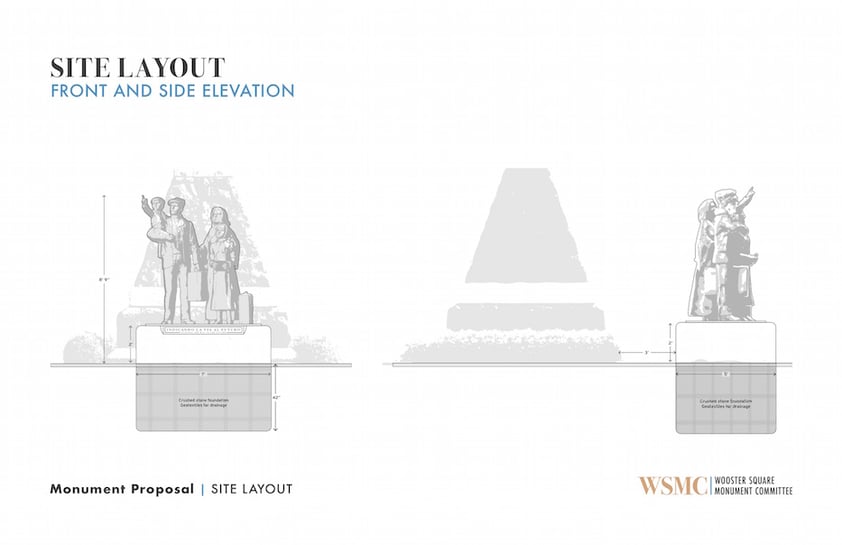
Renderings presented Wednesday night.
Overall, the proposal asks to “increase the overall footprint” of the monument by four feet, Iovanne said. That brings it to 28 square feet of park space.
“We can’t dismiss history,” Iovanne said of the decision to keep the plinth and acknowledge the former sculpture. “We learn from it and we become better people because of it.”
“To those of us who live in the square, the history is there,” he added. “We’re very happy with the design, and that the commissioners are going to give us the right to preserve that. And the new sculpture will tie into this history, because it shows progress.”
As some members of both the committee and the wider New Haven community pointed out last year, Massaro’s sculpture does not represent universal progress to all residents of Wooster Square or New Haven, because they do not all share a history of willing migration or heterosexual, cisgender family building. Wooster Square is the unceded territory of the Quinnipiac People, in a city that endorsed the practice of enslavement until 1848 and sold Black people as property until 1825.
More recently, the neighborhood has become much queerer and racially, if not socioeconomically, diverse.
Historic Preservation, Or Historic Disrespect?
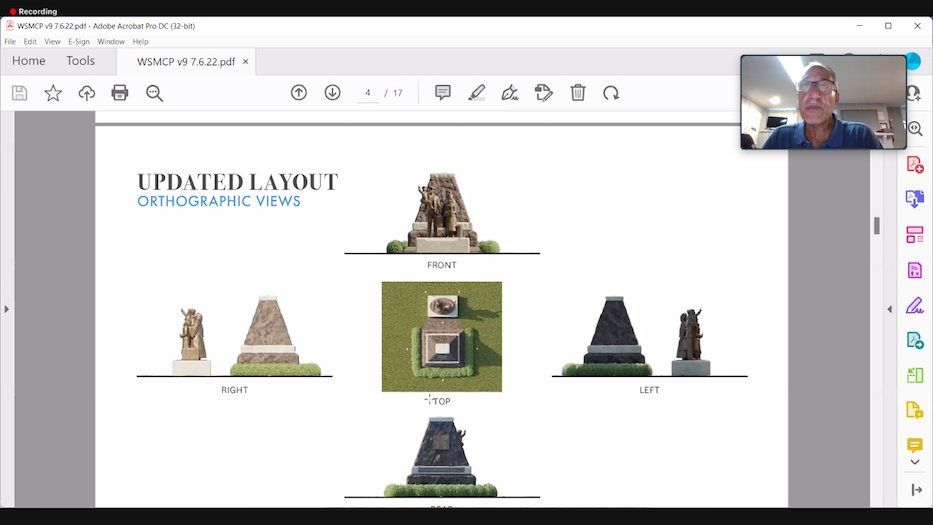
Throughout the night, a central tension emerged between old-school approaches to historic preservation and a more contemporary, philosophical question about who gets to make and preserve history.
Wooster Square neighbors and some WSMC members, all of whom were white, came out overwhelmingly in support of the proposal, some form of which has been in the works since last July. Some called it a chance to preserve city history while ushering in a new chapter; others simply noted that they felt the Historic District Commission had taken long enough to come to a vote.
Commissioners, who discussed the proposal for over three hours in February, kept comments and their own discussion to a refreshingly tight 75 minutes.
Frank Carrano, a member of the WSMC who advocated for the 2020 removal of the Columbus statue, recalled growing up near the park at 462 Chapel St., close to where the Hamilton Street exit now lets cars off of the highway. In his youth, Carrano’s family lived next to the first Lucibello’s Pastry Shop and the Naclerio Family, which marked a century of brewing Foxon Park Soda this year. For him, Wooster Square wasn’t just home: it was a thriving Italian American community full of stories that defined the immigrant experience.
After two years on the WSMC, he sees Massaro’s design—and the story it tells—as “a classic example of the search for the American dream,” he said. He urged the commission to approve the design.
“It is not just one story, but everyone’s story in one way or another,” he said.
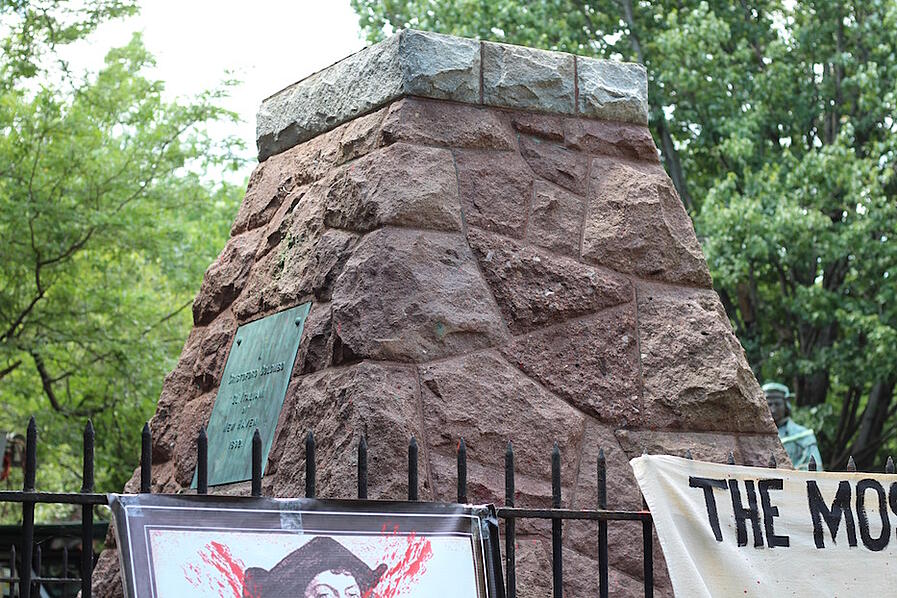
The pedestal in June 2020. Lucy Gellman File Photo.
Filmmaker Steve Hamm, who for years lived on Academy Street and worked on the documentary The Village: Life In New Haven’s Little Italy, praised the committee’s tenacity and willingness to adapt its design based on feedback from the commission. Calling the most recent proposal “outstanding” in a letter to the commission, he asked members to vote to approve the design and send it forward to the three more municipal hurdles it still must clear.
Other takes were more nuanced: Greene Street resident John Lindner wrote in support of the proposal, but noted that he “would prefer the removal of the foundation” for entirely aesthetic reasons. In a letter to the committee, longtime Wooster Square resident Diane Scaglione wrote that she was in favor of Massaro’s sculpture, but could not get on board with the proposal to keep the historic plinth.
“The base without anything atop it looks odd,” she wrote. “I feel that we should have one sculpture on one base in the park and retain the look of the past monument. Bridging the two pedestals while keeping the original bar[r]en would detract from the message and look of the new statue while also not being aesthetically pleasing. I know we can find a way to make our park beautiful, and get our new sculpture finally in place, but I vote against this latest proposal.”
Others pilloried the plinth for more philosophical reasons. Speaking in a steady, unwavering voice, Jenkins objected to the plinth remaining in the park, calling it neither inclusive nor equitable. For her, she said, its very existence in the public space disrespects a “broad consensus” that community members reached two years ago that Columbus—and his harmful legacy—were no longer welcome in Wooster Square.
In particular, it disregards years of advocacy and input from Indigenous people, people of color, and a broad swath of New Haveners in and outside of Wooster Square who called for a more inclusive history in the park. It was they who called for a removal of Columbus, the fawning adoration of whom is not a vestige of Italian history and culture, but part of Benjamin Harrison’s last-ditch attempt to win a second presidential term in 1892.
Why, Jenkins asked, leave the plinth standing there—in front of a brand new sculpture—to remind those people of the legacy that they had worked together to remove from public space? “Somehow the statue left and the pedestal is still there,” she said. “How do we give context to the flaws we now see in Columbus on this pedestal?”
Jenkins also asked her fellow commissioners to consider the historic context of the pedestal—that it cannot be untethered from Columbus, and is now literally standing in the way of making the square a more equitable place. She pointed to recent examples in the American South, where municipalities have begun the removal of pedestals that now stand empty after the Confederate statues they once held came down.
These pedestals are not simply razed; they are preserved, just not in public space. In Richmond, Virginia, for instance, stone pedestals are joining their former sculptures at the city’s Black History Museum.
"We're now called together to reimagine our society to be better, more inclusive, and more equitable," she said. "And so we need to find a common effort across our differences and support our mutual dignity," she said. "... How can context be given to a pedestal for a statue that was removed because its presence was deemed to no longer be appropriate."
As the words floated over an otherwise silent Zoom, it seemed that she was speaking not just for herself and Royalty, who raised the same concern at the February meeting, but for the hundreds of New Haveners who fought for the statue’s removal for years. They include Indigenous and Black voices in the community, whose calls to remove a painful reminder of rape and genocide were heeded only after a white New Haven high schooler started a proposal to take down the statue in 2020.
Jenkins wasn’t alone in her concerns. New Haven Urban Design League President Anstress Farwell, who has opposed the sculpture almost every stage in the process, also spoke out against the design. In February, she defended the plinth’s right to survive, but noted that it might be better off in safekeeping alongside its former companion. Wednesday, she lambasted the current proposal, noting that keeping the plinth intact in front of Massaro’s sculpture—and indeed, blocking the street view—did not make aesthetic sense.
“The combination of the two together is off,” she said.
Where It Goes From Here
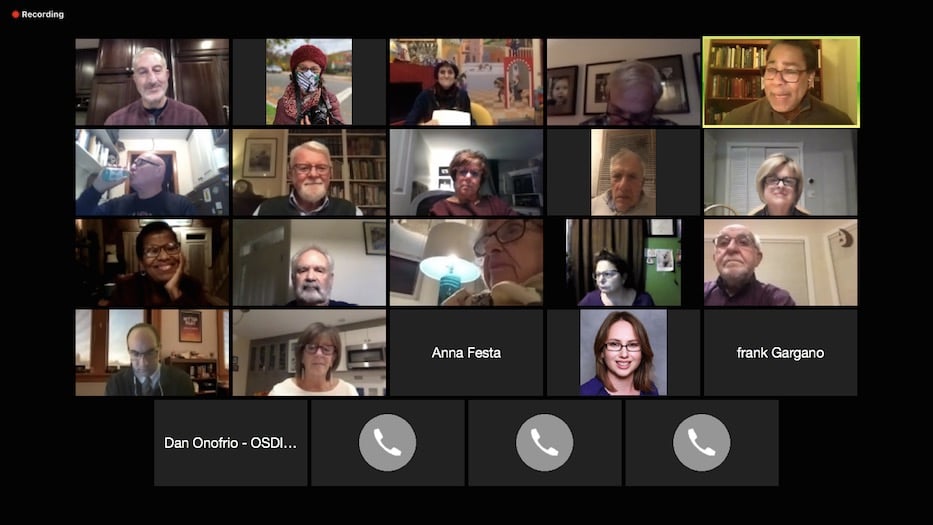
An early meeting of the Wooster Square Monument Committee. Screenshot from Zoom.
In a phone call following the meeting, Iovanne said he felt immense relief to have the vote behind him. For over two years, he and co-chair Laura Luzzi have steered the committee through contentious and at times historically painful discussions, and meetings that have lasted up to four hours. Almost exactly a year ago, Massaro’s sculpture emerged as a committee favorite after members voted on six final proposals for the monument.
Since that time, the design has undergone significant changes, from a landscaped garden to the current iteration. Calling it a “collective team effort,” Iovanne said he is grateful to Wooster Square neighbors and committee members who came out to support the proposal, as well as City Engineer Giovanni Zinn and Chief City Landscape Architect Katherine Jacobs for providing input that helped inform the proposal.
Now that the commission has voted, he said, he is looking ahead to the three more municipal bodies from which the committee must secure votes. In addition, he said, he and fellow committee members plan to begin fundraising for the sculpture. They estimate that the project will take a year and a half once started and cost roughly $270,000.
Past articles about the work of the work of the Wooster Square Monument Committee live under the "Wooster Square" tag.

